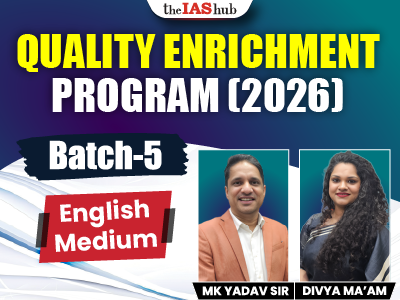[ez-toc]
Earth's Inner Core
Earth's Inner Core: The inner core of Earth may have changed shape in the past 20 years, according to a group of scientists.
- About: The Earth's inner core is the innermost layer of the planet, a solid sphere primarily composed of iron and nickel, located at the very center of the Earth, and is extremely hot with temperatures reaching around 5,200°C.
- Role of the Inner Core: Produces Earth's magnetic field, protecting life from the Sun’s radiation.o Spins independently from the outer core and the planet, and essential for sustaining life; without it, Earth could become like Mars, which lost its magnetic field.
- Connection to Earth's Magnetic Field: Magnetic field jerks in past decades could be linked to inner core changes.
- Possible Cause of Shape Change: Occurs where the solid inner core touches the hot, liquid outer core, driven by liquid metal flow and uneven gravity pull.
- Seismic Wave Analysis (1991-2023): Scientists analysed earthquake shockwaves to study core changes → found inner core slowed around 2010 before speeding up again → Evidence suggests core deformation over time.
- Long-Term Changes: Outer core is freezing into the inner core, but full solidification will take billions of years → by then, Earth may have already been swallowed by the Sun.
Cotton Corporation of India (CCI)
Cotton Corporation of India (CCI): The CCI is likely to buy
100+ lakh bales of cotton at
MSP during the current cotton year.
About CCI: It is
Nodal Agency, established under Ministry of Textiles, Government of India to ensure
equitable cotton distribution, fair prices, facilitates
import-export, and supports cotton farmers, and promotes Indian cotton globally.
Procures cotton at MSP to prevent farmer distress sales.
About Kasturi Cotton India: Launched in 2020 under Ministry of Textiles to promote indigenous premium cotton globally.
Objective: Traceability, certification, and branding of Indian cotton as per benchmarked standards.
- Traceability System: QR-based certification at each processing stage → Blockchain-based software for end-to-end traceability and transaction certificates → Microsite with QR code verification for tracking.
- Implemented at national level and promoted on national & international platforms.
- Fund Allocation: No state-level allocation; funds managed centrally.
- Ginner Empowerment: Ginners across India authorized to produce Kasturi Cotton Bharat as per protocol.
- About Ginning: Essential step in the spinning process → Separates seed, lint, and foreign particles from raw cotton → Provides cleaned cotton for spinning mills.
Immigration and Foreigners Bill, 2025
Immigration and Foreigners Bill, 2025: The Bill is likely to be introduced by Union Home Minister in the ongoing Budget session of Parliament.
About: The Bill aims to
replace existing laws and provide a
comprehensive legal framework for immigration and foreign nationals.
Key Provisions under the Bill:
- Penalty for Unauthorized Entry (₹5 lakh) & Penalty for Fake Passport (₹10 lakh)
- Regulation of Foreign Nationals in universities, hospitals, and medical institutions.
- Provisions for Passports & Visas for entry and exit from India.
- Foreigners’ Registration & Movement Restrictions, control over places frequented by foreigners, liability of Carriers (transporters bringing foreigners into India unlawfully).
- Powers of Central Government: Removal of foreigners, delegation of powers & exemptions.
Existing Laws to be replaced:
- Passport (Entry into India) Act, 1920: Required passports for persons entering India.
- Registration of Foreigners Act, 1939: Required registration of foreigners in India.
- Foreigners Act, 1946: Provided powers to regulate foreigners.
- Immigration (Carriers’ Liability) Act, 2000: Made carriers liable for bringing passengers violating passport laws.
Rainbow capital of the world
Rainbow capital of the world: Due to frequent appearances, a University of Hawaii professor calls Hawaii the
"rainbow capital of the world."
Winter Season: Rainbows are more common during the
rainy season (October–April) in Hawaii.
About formation of Rainbows:
- Sunlight & Raindrops: Rainbows form when raindrops refract sunlight into different colors.
- Best Viewing Time: They appear opposite the sun and seem larger in the early morning and late afternoon.
- Trade Winds’ Role: Hawaii’s trade winds bring small rain showers with enough clear sky for sunlight to create rainbows.
- Clean Air Advantage: Unlike other places, Hawaii has fewer air particles (Dust, Pollen & Pollution), making rainbows more vivid.
Impact of Climate Change: Some regions (Brazil, the Mediterranean, and Central Africa) may see fewer rainbows by 2100.
- Places with less snow and more rain (e.g., Alaska) may see more rainbows.
- Hawaii’s leeward (dry) sides may experience fewer rainbows due to longer dry spells.
Exercise CYCLONE
The 3rd edition of Joint Special Forces Exercise CYCLONE commenced at Mahajan Field Firing Ranges in Rajasthan recently.
About: It is a Joint Special Forces Exercise CYCLONE,
conducted alternately in
India and Egypt.
- The previous edition of the exercise held in Egypt in January 2024
- Participating Contingents: 25 personnel from two Special Indian Forces Battalions & 25 personnel from Special Forces Group & Task Force of Egyptian Special Forces.
- Objective & Focus Areas: Enhance military-to-military relations through interoperability, jointness, and tactical exchange → Focus on high physical fitness, joint planning, and tactical drills → Includes advanced Special Forces skills and modern tactics, techniques, and procedures.
- Benefits: Exchange of best practices in tactical operations → Strengthens bonhomie and camaraderie between Indian and Egyptian troops.
Sudan Virus Disease (SVD)
Sudan Virus Disease (SVD): The Ugandan government and the World Health Organization recently confirmed an outbreak of Sudan virus disease.
About: Sudan virus disease is a viral hemorrhagic fever disease, belonging to the same family as Ebola virus disease, caused by Sudan virus (SUDV). It is a severe disease with high case fatality.
Symptoms & Progression:
- Early symptoms: Fever, abdominal pain, anorexia, fatigue, malaise, myalgia, sore throat.
- Later symptoms: Nausea, vomiting, diarrhea, variable rash, hiccups.
- Severe illness: Hemorrhagic manifestations (bleeding, ecchymoses, petechiae, visceral effusions), encephalopathy, shock, multi-organ failure, spontaneous abortion in pregnant women.
- Recovery issues: Arthralgia, neurocognitive dysfunction, uveitis (may lead to cataracts).
- Persistent infection possible in immune-privileged compartments (CNS, eyes, testes).
- Ebola vaccines are ineffective against Sudan virus.
Transmission & Risk Factors:
- Person-to-person transmission via direct contact with blood, bodily fluids, organs, or contaminated surfaces.
- Higher risk groups: Family members, healthcare providers, burial participants.
- Risk increases with disease severity.
Gender-responsive Budgeting (GRB)
Gender-responsive Budgeting (GRB): The Union Budget 2025-26 has raised the gender budget to 8.8% (from 6.8% in the previous year) of the total allocation.
- About: GRB is a strategy that ensures that government budgets consider the needs of all people, regardless of gender. GRB aims to promote gender equality and inclusive development.
- Four Priority Groups in India: Poor, youth, farmers, and women.
- Female Labour Force Participation Rate (FLFPR) rose to 42% in 2023-24 (from 33% in 2021-22).
- Global average: 47%, but still 37 percentage points behind men’s FLP of 79%.
- Target: 70% women’s participation by 2047 requires investment in skilling, employment, entrepreneurship, and social security.
- Major schemes include: Skill India Programme, Entrepreneurship & Skill Development Programme (ESDP).
- National Skill Training Institutes, DAY-NRLM, MGNREGS, PM Employment Generation Programme.
- PM Vishwakarma, Krishonnati Yojana.
- New schemes: PM Dhan-Dhaanya Krishi Yojana, first-time entrepreneurs’ scheme, sustainable livelihood for urban workers, Centres of Excellence for Make in India.
- Focus on Gig Workers: 90% of India’s working women are in the informal sector.
AI Diffusion Framework
AI Diffusion Framework: The US Framework for AI Diffusion is evaluating India solely based on its AI capabilities, ignoring the
India-U.S. strategic partnership.
About: The framework aims to Preserve U.S. dominance in AI technology → Balance innovation and national security → Restrict AI access to adversaries like China, Russia, North Korea, and Iran.
Mechanism of the Framework:
- The U.S. extends export controls across the entire AI technology stack: AI chips, chip-making tools, and closed AI model weights (essential for AI decision-making).
- Three-tier country classification:
- Tier 1 - Key U.S. allies (unrestricted AI access)
- Tier 2- Other countries, including India (limited AI access)
- Tier 3 - U.S. adversaries (strict AI restrictions).
- U.S. companies can operate in Tier 2 countries but with strict conditions: Limited compute capacity & Restricted
- Impact: India may diversify its tech partnerships to reduce dependence on the U.S.










